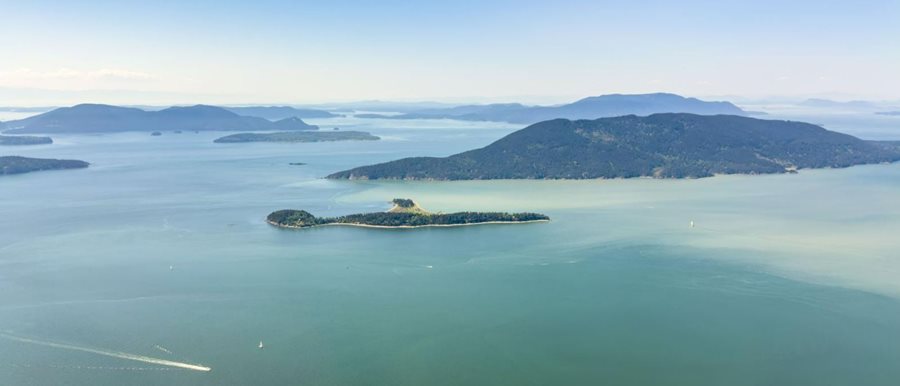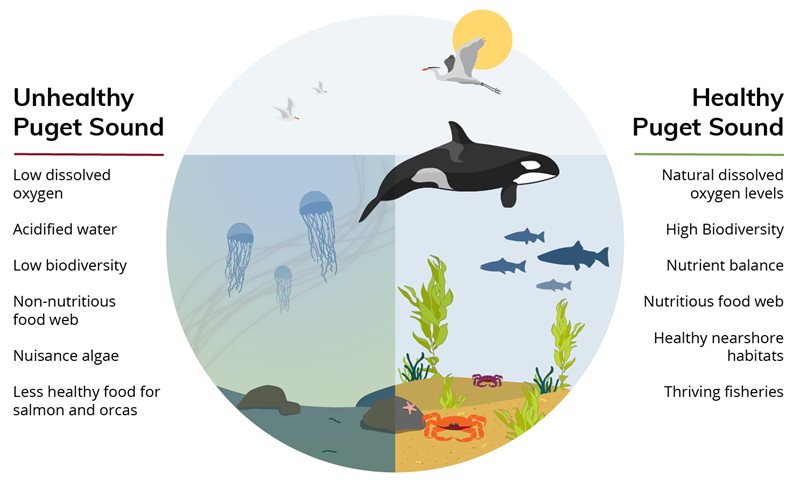
Nutrient pollution is still a problem in Puget Sound. Excess nitrogen from people creates a domino effect in the ecosystem, threatening Puget Sound recovery. We're continuing our work to restore nutrient balance in the Sound by taking a region-wide approach to address all human sources. Our Puget Sound Nutrient Strategy includes improved regulatory requirements, federal and state funding to make improvements, technical assistance, and collaborating with communities on clean water projects.
Wastewater treatment plants and nutrient pollution
In 2021, Ecology established the Puget Sound Nutrient General Permit. This permit addresses the largest source of nutrient pollution in Puget Sound — the excess nitrogen that comes from local homes and businesses and through wastewater treatment plants before entering Puget Sound. As the 58 wastewater treatment plants under the permit work on their plans to invest in nutrient removal technology and reduce how much nitrogen they are sending to Puget Sound, we're sharing an update on a related topic that often comes up: nutrient trading.
Through our process to research and develop the general permit, we were regularly asked about nutrient trading for Puget Sound. That is, would Ecology support a nutrient credit trading program for Puget Sound if it could result in quicker, more efficient nutrient reductions from wastewater treatment plants?
We were directed by the state Legislature to research this issue. In June, we submitted our formal report to the Legislature on recommended structures for a nutrient trading program for facilities covered under the Puget Sound Nutrient General Permit. We are hosting a virtual Puget Sound Nutrient Forum on July 25 that will include a presentation on nutrient trading in Puget Sound. The meeting will also include updates on the Puget Sound Nutrient Reduction Plan and the General Permit, progress on Salish Sea modeling, and time to answer questions. Meeting information and materials are on the Forum webpage.
In the meantime, we encourage you to read more about our work below and explore the report in full.
Water quality trading basics
Generally speaking, water quality trading is a market-based alternative to help meet water quality goals. Trading can be an effective approach to meeting water quality when there are multiple sources of the same pollutant within a watershed, but the costs to reduce pollutant loading greatly vary among dischargers.
Trading assigns pollution reduction activities a water quality improvement value, or a “credit,” which can be traded on a local market to achieve cost-effective water quality improvements. Credits are simply an accounting mechanism to quantify pollution reduction, not dollar costs.
Could trading actually reduce nutrient pollution?
The goal of water quality credit trading is to facilitate exchanges of credits, which can more quickly reduce pollution and clean up impaired waters. Ecology would only consider supporting a trading program for facilities covered by the Puget Sound Nutrient General Permit if it helps permittees make progress toward reducing the amount of nitrogen going into Puget Sound.
What does this mean? For example, for a wastewater treatment plant to participate in trading, they would have to meet a minimum discharge level. Then they would need to identify a facility within their area of impact, and also under the permit, that has reduced nutrient discharges below their permit limit (known as “credit generation”) to offset their potential impacts of higher nutrient discharges. If facilities are not meeting their minimum discharge level and there aren’t any facilities that are reducing nutrients below their permit limit, then there aren’t any credits to trade. Facilities covered by the Puget Sound Nutrient General Permit would only be eligible to trade with one another if the trade will not result in lower water quality in Puget Sound.
Will adding trading make permit implementation more affordable?
Future cycles of the Puget Sound Nutrient General Permit are going to require significant reduction in nutrient discharges from wastewater treatment plants, which will require a significant investment from communities, and ultimately, ratepayers. There are multiple ways for the communities that own and operate facilities under the permit to approach investing in nutrient reductions in ways that are equitable for the people that live in the community. Water quality trading may be an effective part of reducing nutrient discharges while alleviating the financial burden on communities.
Under the permit, facilities must do economic and environmental justice analyses to identify options to mitigate rate impacts to overburdened communities associated with treatment plant upgrades. We encourage all permittees to use the environmental justice analysis to consider more equitable approaches to address affordability concerns for low- to moderate-income households and communities. Many utilities in Washington have low-income subsidy programs. Across the country, some utilities have explored ways to move from equal to more equitable rates, including variable rate structures and census track analysis.
Next steps for trading in Puget Sound
So, is nutrient trading on its way to Puget Sound wastewater treatment plants? We aren’t sure, yet.
Our recommendations to the Legislature include establishing a very simple trading program to start, eligible only for the wastewater treatment plants covered under the general permit. The program would have restrictions in place to alleviate any risk of reduced water quality in areas where trades occur.
It only makes sense to move forward with such a program if there is sufficient interest from permitees, Tribes, and communities. This is why we are kicking off our initial outreach on nutrient trading in Puget Sound with an informational webinar, so we can share what we have learned and hear from you.
We hope you can join us on July 25 at 9 a.m., register on Zoom for any meeting updates.


